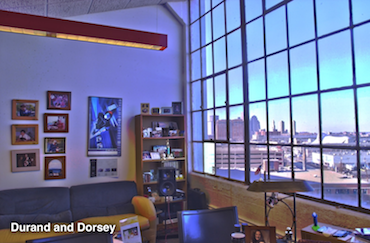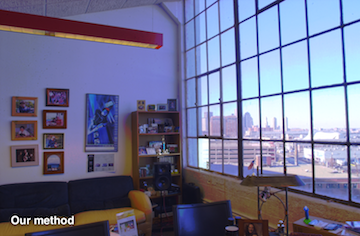 |
| The square-wave pattern with a reduced amplitude of the
fundamental frequency, resulting in countershading profiles. The
regions of indistinguishable (from a step edge) and objectionable
countershading are marked with dotted and dashed lines of
different color. The higher magnitude of countershading produces
higher contrast edges. But if it is too high, the result appears
objectionable. The marked regions are approximate and for
illustration and actual regions will depend on the angular
resolution of the figure. Note that the spatial frequency shown on
this plot is inversely proportional to the profile width sigma. |
Abstract
Countershading is a common technique for local image contrast manipulations, and is widely used both in automatic settings, such as image sharpening and tonemapping, as well as under artistic control, such as in paintings and interactive image processing software. Unfortunately, countershading is a double-edged sword: while correctly chosen parameters for a given viewing condition can significantly improve the image sharpness or trick the human visual system into perceiving a higher contrast than physically present in an image, wrong parameters, or different viewing conditions can result in objectionable halo artifacts.
In this paper we investigate the perception of countershading in the context of a novel mask-based contrast enhancement algorithm and analyze the circumstances under which the resulting profiles turn from image enhancement to artifact for a range of parameters and viewing conditions. Our experimental results can be modeled as a function of the width of the countershading profile. We employ this empirical function in a range of applications such as image resizing, view dependent tone mapping, and countershading analysis in photographs and works of fine art.
Detailed description
Local contrast enhancement is a powerful image processing technique, fundamental to many aspects of computer graphics such as image editing and tonemapping of HDR images. The countershading operation is one of the most common approaches to enhancing local contrast in images, where the local edge contrast is increased by adding gradients to either side of the edges. These gradients, known as countershading profiles, result from numerous algorithms. Regardless of the method of introduction, the result resembles that of the unsharp masking (UM) operator.
Unsharp masking with a narrow high-pass filter can increase the apparent sharpness of the image, making fine details easier to identify. On the other hand, unsharp masking with a wide high-pass filter can increase the contrast of the regions adjacent to the edge, altering the overall impression of contrast in the image. Sufficiently wide unsharp masking profiles can even induce the Cornsweet illusion, where the entirety of adjacent regions change in appearance.
However, unsharp masking can also introduce objectionable countershading around an edge, frequently referred to as haloes. In these cases, the contrast enhancement detracts from the image, providing neither improved understanding nor aesthetic quality. The same operation can be interpreted as an enhancement in some cases, while it's interpreted as an artifact in others. We present a method of introducing perceptually-symmetric countershading profiles and conduct a perceptual study to determine the amount of local contrast that can be introduced by our operator without becoming objectionable. The goal is to find a boundary between where the result is considered contrast enhancement and artifact.
We discover the perception of countershading profiles follows a U-shaped characteristic, where certain width profiles are considered unacceptable even if only slightly visible, separating adjacent regions of both wider and narrower countershading profiles with considerably higher levels of tolerated contrast. The regions of indistinguishable and objectionable countershading vary with the width of the countershading profile and its amplitude. The important observation is that countershading profiles indistinguishable from a plain edge provide only very limited contrast enhancement; thus the region below objectionable countershading needs to be used to achieve high-quality results. We find that these regions correspond to the various semantic descriptions of the images resulting from different unsharp masking parameters. The trough of the curve consists of profiles considered haloes, while narrower profiles were perceived to sharpen image features and wider profiles were perceived to enhance contrast.
The benefit of this work is an understanding of how changes in the profile width affect the perceived quality of countershading, including those resulting from image downsampling and changes in viewing conditions such as display dimensions and distance. The results of our study can be used to avoid introducing artifacts when performing local contrast enhancement. However, the scope of our findings is limited by the small set of conditions and local contrast operators we were able to investigate in our study, a trade-off necessary to obtain accurate results for that set. Moreover, we show that our findings cannot be explained by the existing perceptual models; thus these models cannot be used to extrapolate the data to a broader range of conditions. As such, while relevant to numerous methods, our results are best taken as guidelines when processing complex images.
Results
 | ||
Downsizing an image (a) transforms a 1.84 degree countershading profile to a smaller one, where the threshold of objectionable magnitude is significantly reduced, causing objectionable haloes. These artifacts can be remedied by adjusting the magnitude of the countershading (b) to correspond to the new angular size of the profiles or adjusting the width of the countershading (c) to compensate for the downsample factor, or some combination thereof. Neither image in this simple case appears exactly the same as the full-size, but they do not include objectionable artifacts. The same applies in the opposite case, when a sharpened image is enlarged (d).   A comparison between the sigma_s specified in Durand and Dorsey (left) and our sigma_s chosen for the size of the image in this paper (bottom). The contrast of the counter-shading has not changed, the profiles have been sufficiently widened so the contrast is no longer objectionable. | |
Video
Files
| Paper | [pdf] [bib] |
| Artifact-free countershading samples | [html] |